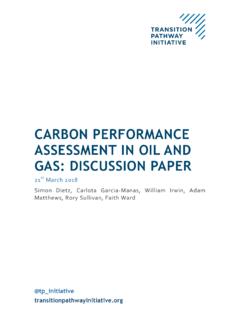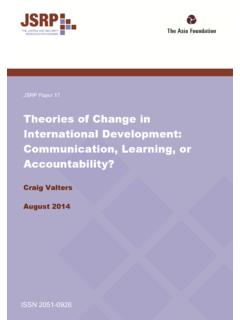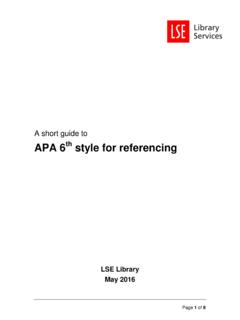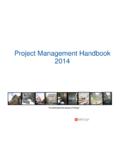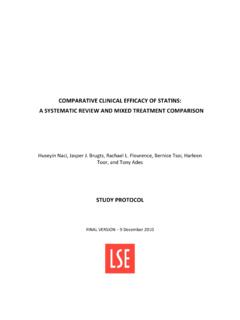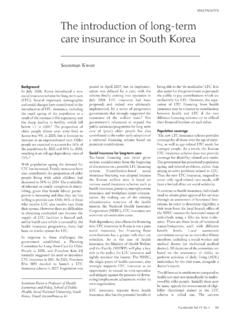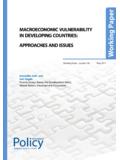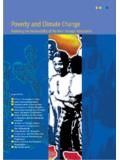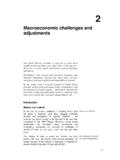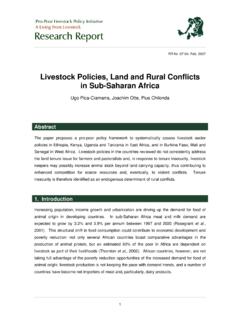Transcription of Global economic recession: effects and …
1 1 Global economic recession: effects and implications for South Africa at a time of political challenges. Claves de la Economia Mundial Vishnu Padayachee1. 1. Introduction: Africa s relatively weak Global linkages suggested to some that it would be spared the worst effects of the Global crisis which hit many developed and emerging market economies from around September 2008 (Bakrania and Lucas: 2009). However the region as a whole has indeed been exposed to the downturn and growth estimates for the continent have been continuously lowered from 5 percent in 2008 to percent in April 2009 (IMF, 2009). The main channel for this negative effect has been via the recession-induced slow-down in foreign financial flows of all types into Sub-Saharan African and the region s dependency on commodity based export growth. The South African case: South Africa and the Global economy: 1 Professor and former Head of the School of Development Studies, University of KwaZulu-Natal, Durban: and Fellow, Stellenbosch Institute for Advanced Study, University of Stellenbosch.
2 I acknowledge the benefit of a long-standing conversation Keith Hart on South Africa s place in the world economy and the support of my research assistant, Christy McConnell. 2 Unlike most other countries on the continent, South Africa has historically been a significant player in international markets: its economy is more open than many industrialized countries. The open world economy which stimulated so much international migration in the period before the first world war found in South Africa one of its growth engines as well as one of its most contradictory crucibles of imperialism. The Global recession and South Africa: economic considerations: Given this Global engagement expectations were that South Africa would feel the effects of the Global recession both quickly and deeply, and in ways which added to the economic problems created by race, inequality and the structural problems associated with the nature of its brand of capitalism.
3 The Chilean-born, Cambridge economist Gabriel Palma speaking to a audience in Cape Town in September 2009, observed that unlike almost all other middle-income countries, [South Africa] had entered the crisis with a greater degree of vulnerability, namely a very large current account deficit, high interest rates and high inflation . He argued that South Africa had to re-impose capital controls, relinquish the independence of its central bank, jettison inflation targeting and address the problem of its over-sized and unproductive financial sector, a legacy of a long period of (US-type) financialization of its economic activity. (Business Day 14 September 2009). In contrast, top South African officials initially took a different position to the emerging crisis. Trevor Manuel, the former Finance Minister, now Minister in the Presidency in 3 charge of the National Planning Commission, reacted to the crash in Global markets in late 2008 with the view that South Africa would not be badly affected.
4 Even when signs in the real economy were pointing to serious problems in early 2009, Trevor Manuel insisted that South Africa was not in a recession! Part of the reason for this more optimistic picture arose from the experience of the late 1990s Asian financial and currency crisis, which South Africa weathered very well. The government attributed that earlier success to the soundness of its home-spun structural adjustment program, the Growth, Employment and Redistribution program (GEAR) which saw key macroeconomic balances fall within IMF norms quickly after the democratic elections of 1994. Since then the country experienced sustained, though far from spectacular, rates of economic growth from 1999 to 2007. Inflation fell comfortably within the inflation targeting range of 3-6 per cent between late 2003 and 2006, testing and later breaching the upper limit only from mid-2007. The budget deficit and current account deficits were both under control.
5 But things then begin to change after 2007 in the key macroeconomic balances and the fragility and vulnerability in the real economy that had been evident for sometime could not easily be swept away with technical talk about the macroeconomic fundamentals being right. The country s GDP growth rate dropped to percent in the last quarter of 2008, then plunged to percent in the first quarter of 2009, and to percent in the second 4 quarter. So the country fell into a technical recession already at the end of the first quarter of 2009. Manufacturing output in the first quarter of 2009 declined by per cent relative to the previous quarter, while mining production declined by percent over the same period. Similar contractions are apparent in the retail and wholesale trade sales, with motor vehicle sales (domestic and export) in particular falling sharply. (SARB Quarterly Bulletin, various) 484 000 workers lost their jobs in the third quarter of 2009, the largest number in manufacturing (about 150 000): the total job losses were more than the combined total of the first two quarters of that year taking the official unemployment rate to percent and total (official) job losses up to the end of the third quarter over the million mark.
6 To these figures should be added some million workers who are excluded from the calculations because they have ceased actively searching for work, ie the so-called discouraged workers syndrome, taking the real unemployment rate to about 32 percent! (Business Day, 30 October 2009). Turning to macroeconomic balance indicators, inflation breached the outer limit of the target range (3-6 percent) and CPIX stood at an average percent for 2008. The current account deficit as a percent of GDP arose from a very modest and manageable percent in 2003 to a disconcerting percent in 2008, an alarming 7 percent in the first quarter of 2009, and a further 3 per cent fall in the second quarter of 2009. Though initially this deficit was easily financed by steady foreign capital inflows (mainly portfolio investment but also some FDI) the tremors in Global financial markets from around September 2008 threatened the sustainability of this key ratio, for long regarded 5 as the achilles heel of the modern South African economy (SARB Quarterly Bulletins, March 2009, June 2009 and September 2009).
7 The Reserve Bank after a long period of successive Repo (bank) rate hikes from April 2005 (which saw the rate rise from a low 7 percent to 12 percent in June 2008) began cutting its key Repo rate from the latter date, to its current low of 7 percent at end December 2009 the lowest rate in 27 years! The Johannesburg Securities Exchange all-share index fell from a high of 32 542 on 23 May 2008 to a low of 18066 on 21 November 2008, but volatility and uncertainty in the market was as worrying as the absolute fall. New listings remained subdued throughout 2009. The all-share index has since picked up, and it stood at 27 895 as of 5 January 2010 (Business Day: 5 January 2010). Depressed Global conditions and lower liquidity on Global financial markets also impacted on the rand-denominated bonds in the European and Japanese bonds markets in 2009. Turnover in the secondary domestic bond market fell in 2009; bond prices weakened and a much reduced level of participation by non-residents in the domestic market is detectable (SARB Quarterly Bulletin, September 2009: 43-45).
8 The local property market has weakened since late 2008, but without the devastating consequences for low-income home owners felt in the US and to some extent in the UK. (SARB Q/B September 2009). House price deflation continued in 2009, maintaining the downward trend noticeable in late 2008: this despite the serial lowering of the Repo and 6 mortgage rate, which appear to have been off-set by commercial banks tightening lending conditions. Activity in new home construction also slowed as demand weakened, in part a consequence of depressed conditions in the labour market and a decline in household income expectations. However, millions of poor South Africans exist outside these formal property and real estate markets in sprawling informal settlements and slums. The Zuma government appears to be making a more concerted effort to accelerate state housing provision but slowing economic activity nationally is being felt in lower aggregate taxation and in the context of so many competing demands on the fiscus, the ambitious targets to eliminate informal settlements (the language of the state) and resettle these communities in low cost houses by 2014, may be jeopardized.
9 Some attention has been paid in recent literature to the effects of the Global economic recession on South Africa, focusing on the implications for growth, poverty and employment (see for example Marais, 2009: Jacobs, 2009)). I want to address here, two issues, banking and black economic empowerment, which have not received as much attention, but which are significant for South Africa, in the context of the economic transformation of the country after apartheid. 2. South Africa: the banking sector. 7 A Financial Mail analyst observed that one reason why South Africa would weather the Global turbulence better than most was its effectively regulated and well-capitalised banking and financial sector. Remaining exchange controls measures for residents and a relatively stable macroeconomic management combined to insulate South African banks from the shocks originating in the US sub-prime market, he argued.
10 Of the country s top banks only Investec, the smallest but most aggressively internationalized bank appears to have taken somewhat of a direct knock. As early as November 2007 Investec reported a 36 million pound sub-prime hit and a sharp fall in its share price, though this exposure pales into insignificance when compared to the US and UK write-offs. (Financial Mail: 13 March 2009). A Business Day analyst compares European banks with an average leverage (debt to equity) ratio of 35 per cent and the big Global investment banks with a leverage as high as 50 to 60 percent with South Africa s big four banks with an average leverage of about 16% - in the lower quarter for leverage internationally. Former Reserve Bank Governor Tito Mboweni pointed out that South African banks had improved their capital ratios in the past year, noting that the country s banks were strong and healthy and that the capital adequacy ratio was increased from percent in January 2008 to 13percent in December 2008 (Business Day: 2 March 2009).
